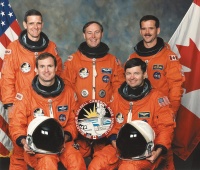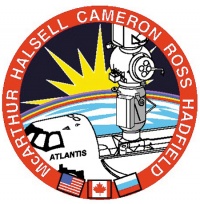STS-74
From The Space Library
 | |
| Organization | NASA-Office of Space Flight (United States) |
|---|---|
| Mission type | Human Crew |
| Launch date | November 12, 1995 |
| Launch vehicle | Space Shuttle |
| Launch site | Cape Canaveral, United States |
| COSPAR ID | 1995-061A |
| Inclination | 51.6 degrees |
| Experiments | Here |
| Alternate Names | 23714 |
| Additional Information | Here |
| Data Collection | Here |
| Payload Mass Up | 6134 kg |
| Payload Mass Down | 1790 kg |
| Orbiter | Atlantis |
| Lift Off Mass | 2,050,816.82 kg |
| Orbiter Weight at Liftoff | 112,595.00 kg |
| Orbiter Weight at Landing | 92,897.73 kg |
| Landed | Concrete runway 33 at Kennedy Space Center, Fla. |
| Orbits of Earth | 129 |
| Orbital Altitude | 213 nautical miles (245 statute miles) |
Contents |
[edit] Crew
- Commander: Kenneth D. Cameron
- Pilot: James D. Halsell Jr.
- Payload Commander:
- Mission Specialist 1: Chris A. Hadfield, Canadian Space Agency
- Mission Specialist 2: Jerry L. Ross
- Mission Specialist 3: William S. McArthur Jr.
- Mission Specialist 4:
- Mission Specialist 5:
- Payload Specialist 1:
- Payload Specialist 2:
ISS/Mir Crew Transport
[edit] Mission
The STS 74 mission was the second of seven planned Space Shuttle-Mir link-ups between 1995 and 1997, including rendezvous and docking and crew transfer, which will pave the way toward the assembly of the International Space Station beginning in November 1997. Major objectives included docking with the Mir space station and delivery of a Russian docking module and 2 solar arrays. This mission marked the first time astronauts from the European Space Agency (ESA), Canada, Russia and the US were in space on the same complex at one time -- a prime example of nations that will be represented on the ISS. The crew consisted of commander Kenneth Cameron, pilot James Halsell, mission specialists Jerry Ross, William McArthur and Chris Hadfield. Atlantis carried the Russian-built Docking Module, which had multi-mission androgynous docking mechanisms at top and bottom. During the flight of Mir, the crew used the Orbiter's Remote Manipulator System robot arm to hoist the Docking Module from the payload bay and berth its bottom unit atop Atlantis' docking system. Atlantis then docked with Kristall using the Docking Module. Atlantis also delivered water, supplies, and equipment, including two new solar arrays (one Russian and one jointly-developed), to upgrade the Mir. It returned to Earth experiment samples, equipment for repair and analysis, and products manufactured on the station. Also flown was the GPP payload consisting of two experiments -- the GPP experiment and the Photogrammetric Appendage Structural Dynamics Experiment (PASDE), managed by GSFC's Special Payloads Division. The GPP studied the Earth's thermosphere, ionosphere and mesopshere energetics and dynamics using broadband spectroscopy. It also interacted with the atmosphere by observing Shuttle and Mir glow, Shuttle engine firings, water dumps and fuel cell purges. Three PASDE cannisters, located throughout the cargo bay, photogrammetrically recorded structural response data of the Mir solar array during the docked phase of the mission. These data will be analyzed on the ground to verify the use of photogrammetric techniques to characterize the structural dynamics of the array, thus demonstrating that this technology can result in cost and risk reduction for the ISS on-orbit structural verification.
[edit] EVA
[edit] Payload
Shuttle-Mir Mission 2; docking module with two attached solar arrays; IMAX Cargo Bay Camera (ICBC); Glow Experiment (GLO-4)/ Photogrammetric Appendage Structural Dynamics Experiment (PASDE) Payload (GPP); Shuttle Amateur Radio Experiment (SAREX) II
[edit] Books about the Space Shuttle Program
Buy This Book Click here |
Buy This Book here |
Buy This Book Click here |
Buy This Book Click here |





